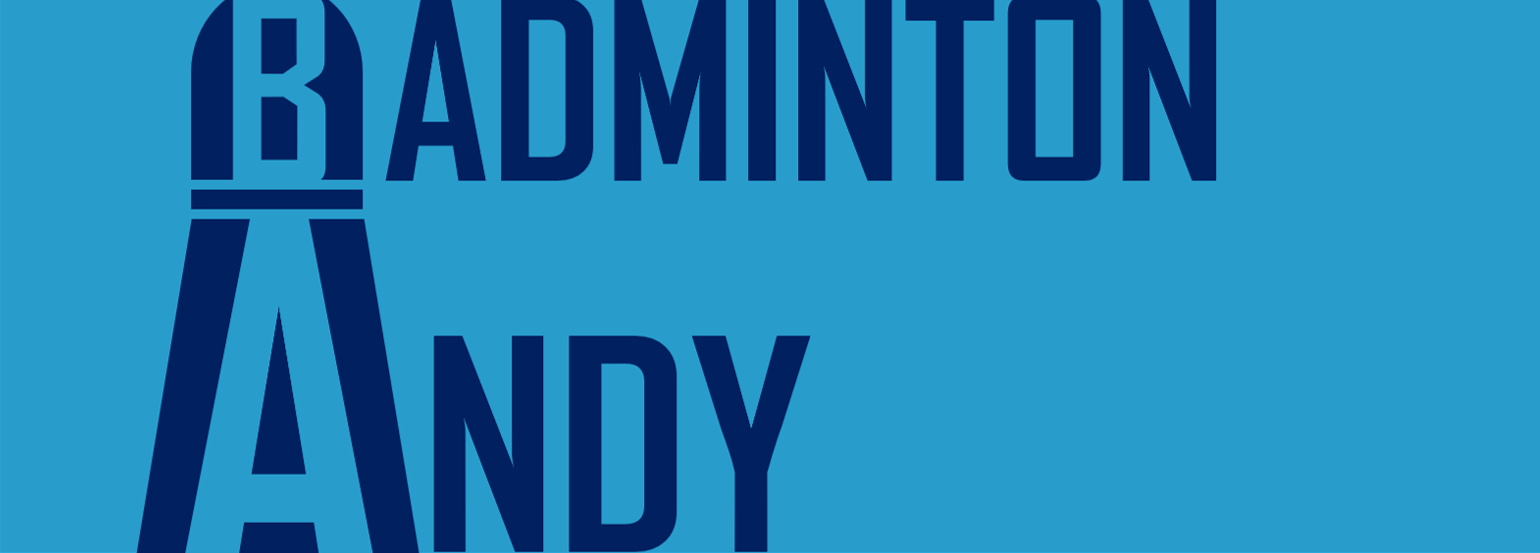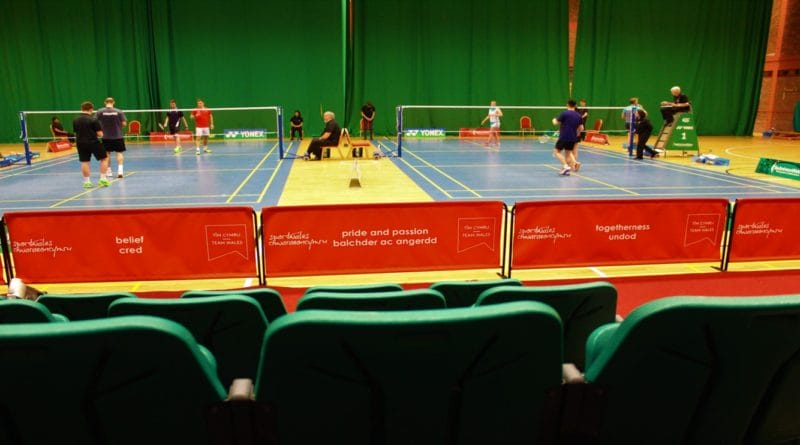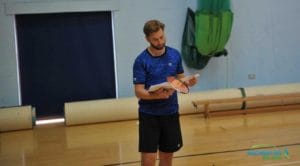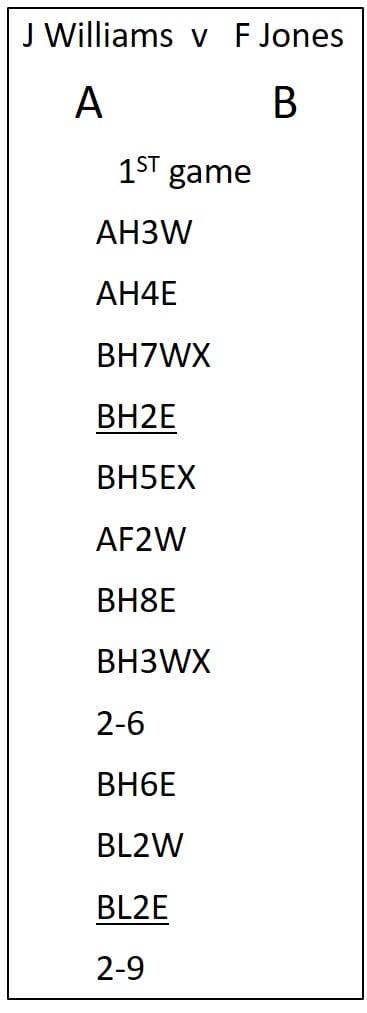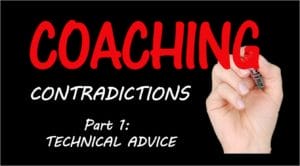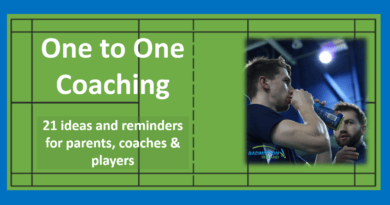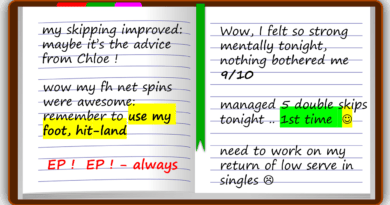6 Ways to improve your observations
Have you ever wondered what coaches see when they are watching matches and practices?
-
What methods do they use?
-
Do they study parts of the game or movements?
-
How do they record what they see?
I’ve asked other coaches all these questions and been surprised at the replies. They seem so obvious.
These 6 ways will use their suggestions and hopefully will improve your observations
They are not just for coaches, anyone who sits behind the court will get an insight
– – – – – – – – – – – – – – – – – –
1 Where to sit?
2 Decide what to look for
3 Record them somewhere
4 Notation methods, 3 to think about
5 Your development, it’s tough at the start
6 Watch with friends
– – – – – – – – – – – – – – – –
1 Where to sit

Vary where you observe from. However, the best place is often to sit directly behind the court at a slightly raised level.
Observing from the side is difficult as your head will have to move from side to side to follow the shuttle. I get dizzy with all the head turning, especially if I am trying to take notes (no. 4) and concentrate.
Sitting behind the court will help make observations of a players movements towards the shuttle, and in recovery, easier to see. You will find that you start to ‘play’ the rally as if you were in the game itself.
– – – – – – – – – – – – – – – –
2 Decide what to look for
Regular observations of a player give you the opportunity to focus on one particular element. You could choose between technical, tactical or mental aspects. However, it can be difficult to know what to look at.
Even if you’ve watched badminton matches before, trying to look at details can be tough and mentally tiring. It’s a challenge, one that is worth mastering if you want to improve your knowledge and enjoyment.
What do you look at first
I recommend that at the start you don’t try to watch both players at the same time. Focus completely on the player in front of you and just watch. Don’t think about anything specifically, get used to just watching that player.
Think about these questions
.. has anything surprised you whilst you’ve been watching?
.. can you see movements being repeated?
.. are the hitting techniques as you expected?
.. which aspects have you found yourself concentrating on?
Observing players you know
Prepare yourself before the match by recalling some of the things you observed last time. Refer to your notes, if you’ve previously taken any! 🙂
Set out to see if what you think happened previously happens again. It’s a great way to prepare your eyes. Create an image from your previous observations, remind yourself of what you observed and liked/disliked/questioned. Doing this will help you and it may even surprise you.
If you’ve been working on things in prctaice and now you see the results, its time to smile
Remember, small improvements are important, so look for them
What’s your comparison model
Have you read this post … 6 Ways to work out what to coach next and when to coach it.
There are several points that will give you some thoughts to help your observations.
– – – – – – – – – – – – – – – –
3 Record them
Do you carry a notebook?
My old ones would make interesting reading whilst having a cup of tea!
I am often surprised at the comments that I made 10+ years ago and how my opinions have changed on some topics.
Recently I have started to open up the memo on my phone. Then I email the notes to myself. If like me you use Microsoft OneNote or the Evernote to store your observations as I do, please let me know.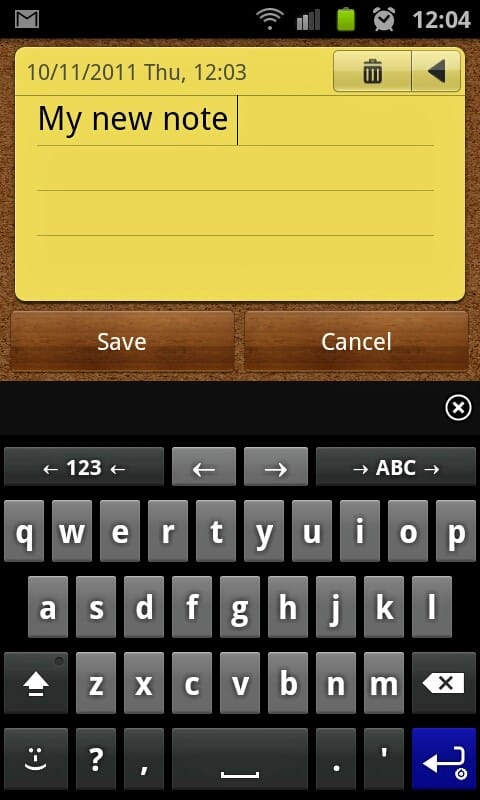
Do not rely on your memory to be specific over a long period of time. Even after one day an event will be difficult to recall. Observations not recorded may become unsound very quickly. Keeping a record of what you see will help you prepare for future observations and decisions for coaching or feedback.
I know it’s obvious, but please remember to place the date at the start of any observations and a quick description of what you were looking at.
I’ve looked through old comments and notes then struggled to remember when I made them and in what situations they occurred.
Be Positive!
Reviewing your records will also allow you to see where your focus was during the match. Be aware of not just recording negative aspects. As important are the observations of improved performance.
Try to record something positive from every session no matter how small
– – – – – – – – – – – – – – – –
4 Notation methods
I’ve tried many methods and I’m sure that there are plenty of others. Whatever you choose, the most effective one is certainly not your memory. I use pen and paper as I find it quicker to record the observations.
I have seen people using phones or tablets and maybe they have some special customised software. If you use an electronic system please leave a comment and share your system.
Would you like to help me write the a post called “6 Ways to Analyse a Badminton Match”
What ideas and the systems you are using do you use?
Here are 3 systems for you to try next time you are in the hall
 System 1
System 1
This method identifies where the rally ended and if it was a winner or error. You will need to hold 2 pens, however, if you want, use ‘x’ and ‘o’.
Winners can be those that hit the court without being touched or where the opponent makes a ‘forced error’.
It simply shows where the rallies ended on one side of the court. You could try both sides at the same time if you wanted. The example above just shows your opponents court and your net area.
Therefore all the black ‘x’ are your winners and the red ones are where your shot went out the side, back or into the net.
It doesn’t show what shot they were or how long the rally was. However, at the end of the match, you can easily see ‘hot spots’, areas where there are clusters of either winner or errors.
 System 2
System 2
This method was developed by Roger Mills.
It records the rally by using a series of letter and numbers.
A – player identification
H – High Serve
L – Low Serve
F – Flick Serve
3/4/8 – number of rally shots
W – winner to end the rally
E – error to end the rally
AH8W : player A served High, the rally was 8 shots long (inc. the serve) and it ended by an outright winner from player A
BH2E : player B served High and player A made a mistake with their return of serve i.e. only 2 shots in the rally
Before you try, think about the following questions
.. What is the average length of a singles rally to normally observe with these players?
.. How many returns of service errors (hit out or into the net) do they normally make?
.. Are the rallies shorter when a low serve is used?
I’ve always been surprised at what this notation shows compared to what most players/parents/coaches believe happens in the singles games they watch. Not everyone players like Kenta Momota or TZY 🙂
System 3
If you are recording how your player performed in terms of the attitude and behaviour between rallies then simple short sentences can be effective. Record in a way that sums up what you see and link them to the score. This way you can see if there is a link between the score and the behaviour you observe.
You can also record what you see in term of tactical choices
4 – 2 great st slice and follow up to net
5 – 2 taking more time between rallies
7 – 3 deep bh always going st, need xc
15-17 great st clear off HS
18 – 19 forgot HS ritual and rushed service
19 – 21 fighting attitude much improved 😉
– – – – – – – – – – – – – – – –
5 Its tough at the start
Initially, you may find that there isn’t enough time to record your findings. The gap between rallies can seem very short. Some players take so little time between rallies that you may wish to record this if you coach one or both of them.
If you seem to be observing this in lots of games, why not a take a quick scan of these two posts. Hopefully, you will find something useful 😉
6 Ways to Prepare & Practice for the Big points
If you see lots of different aspects and feel overwhelmed, don’t worry. The more you become aware of, the more you will want to record.
Try sitting next to someone who is used to taking notes and ask them what they record. Selecting what to record is just as difficult as deciding how to capture the information.
Whatever you record and whichever aspects you consider, try to find time to review immediately after the game. Clean up your notes, add more comments or delete things that don’t make sense. Also, delete things that didn’t happen.
I’ve looked back at my notes and realised that I have been far too hard on certain points and that they didn’t really reflect what happened.
Remember not to just focus your words on negative aspects.
Try sitting next to someone who is used to taking notes and ask them what they record
– – – – – – – – – – – – – – – –
6 Observe with friends
Hopefully observing should always be a pleasurable experience! Don’t be too hard on yourself, if you miss details.
In time you will be able to come back to a particular movement and take pleasure in knowing you are now able to see more detail. Develop your skill through practice and you will become more effective.
As you gain experience you will find that your mind will simultaneously absorb and analyse several elements of a game. Observations will gradually increase in complexity.
Look for where the movements are initiated, trace a technique through its movement, identify causes of winners or errors. The more you practice your observations, the more you will see.
Trust your instincts and allow them to develop
I find that after the event I can sit quietly and recall different thoughts
Especially whilst driving home afterwards
A quick story
Three coaches watching the same match.
one exclaims “did you see that return”,
the second adds “that happened the last time they received a low serve from the LH court”,
the third coach replies “which player are you two watching!”
– – – – – – – – – – – – – – – –
Challenge Time : what actually happens?
I do this whilst watching world-class players at big events or on TV. Think about the questions or statements coaches have made to you. Often coaches will say that movements or strokes should be played this or that way.
Check to see how players actually move on court and compare to the model you adhere to.
Time spent observing small elements will help define your beliefs: does what you believe actually happen.
What do you see this when you look at matches?
I have heard these statements
“Top players take 3 steps to get everywhere around the court”
“Elite male players all chasse rather than run”
“No elite players have big backswings at the net”
“Recovery from the RTH is by always using a chasse”
Have you read this post, Contradictory Badminton Advice, it’s full of statements that you could observe in matches and practice.
I wonder which ones you will see on court and agree with.
Become a Badminton Detective !!
